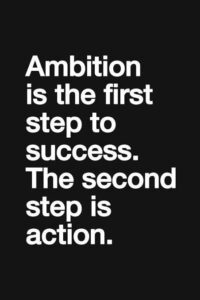We were told to dream big. Aim for top roles, meaningful work, great pay, and a flexible life. That advice builds ambition, the energy that points you toward a future you actually want. Then reality shows up: online assessments that feel like IQ marathons, markets that tighten overnight, hiring freezes and reorgs, promotion rules no one explains, the limits of time and energy, family responsibilities, and the slow, very human work of turning interest into real skill.
If you’ve ever thought, “I know I can do more—so why isn’t it happening yet?” you’re standing between those two forces. The problem isn’t that your dream is too big or that you’re not talented. The problem is the distance between what you want and what your current skills (what you can do), signals (proof you can do it), social capital (who trusts and remembers you), and systems (your weekly habits) can reliably produce in this market, right now.
This article does three things:
-
Defines ambition and reality in career terms.
-
Explains the gap, why it appears, and how to diagnose it.
-
Gives you a bridge on the practical, repeatable system to close the gap quarter after quarter.
What is Ambition?
Ambition is your self-chosen directional energy and a steady pull toward a future that actually fits you. It blends a clear vision of the work and life you want, the values you refuse to trade, the motives that keep you going on hard days, and the identity you are growing into. When ambition is healthy, it is yours, not borrowed from trends or someone else’s highlight reel. It tells you what you want, why it matters, who it helps, and which skills you will rely on and grow. The easiest way to make it useful is to put it into one specific sentence and let that sentence shape your week. Try this:
“In 12 months, I want to be a Product Analyst in healthcare tech because I care about access, and I enjoy SQL, stakeholder discovery, and building dashboards that cut response times.”
Then turn the idea into small moves you control. Block practice hours, create simple case studies, show your work in public, and speak with people who do the job today. If life or location creates real limits, choose a bridge role that builds the missing skills while keeping the same destination. Watch out for two common traps. Vague ambition cannot guide a calendar. Prestige ambition sounds impressive, but fades when no one is watching. Ask yourself two questions often. Does this goal energize me today? Can I take one concrete step toward it this week? If you can answer yes, your ambition has stopped being a wish and started acting like a direction.

What is Reality?
Reality is the terrain you’re hiking on, while your ambition is the mountain you’re aiming for. It isn’t anti-dream and it isn’t personal; it’s the mix of conditions, constraints, incentives, and timing that shape what’s possible right now. In careers, reality has four layers that constantly interact.
- Market layer: roles that are expanding or shrinking, skills that are in demand, salary bands that are moving with the economy, the seasonality of hiring, and shocks like reorganizations or funding droughts.
- Organizational layer: headcount plans, promotion bars, budget cycles, the projects leadership actually cares about, who has decision rights, and the unwritten rules that govern how visibility and sponsorship work.
- Life layer: your available time, energy, money, health, family duties, visas, location, and any season of life you are in that sets real bandwidth.
- Self layer: your current skills you can perform on demand, your proof of those skills in the form of outcomes and artifacts, your reputation for reliability, your relationships, and your routines.
When you feel stuck, it is usually because one or more of these layers is misaligned with your ambition. Making reality useful starts with measurement rather than judgment. Begin by establishing a baseline you can improve. Map what the market is hiring for by reading ten recent job descriptions in your target area and noting the repeated skills and tools; skim earnings calls or product blogs to see where that industry is actually investing; write down your organization’s current priorities in one or two sentences and match your work to those priorities.
Why Smart, Hardworking People Still Get Stuck And How to Overcome This
If you’ve ever looked at your goals, looked at your calendar, and felt that quiet “why isn’t this moving?”You’re not alone. Most careers live between two forces. On one side is ambition, and on the other side is reality. Here are some reasons why smart and hardworking people get stuck.
1. Using skills without shipping results
You read, practice, and take courses, but too little of that turns into something a manager can actually use today, so progress feels theoretical. This happens when work stalls at “I understand it” instead of “I built it, it works, and here’s what changed.” The cure is to move from learning mode to delivery mode. Pick one skill that matters for the role you want and ship a tiny, real output every week.
2) Talking about effort, not evidence
You work hard, but when someone asks, “What changed because of you?” your answer sounds like a task list rather than a result, which makes decision-makers hesitate. People who approve offers, promotions, and budgets are busy; they scan for evidence, not enthusiasm. Turn each win into a one-minute proof: the problem you saw, what you changed, one simple number or screenshot that shows the difference, and what you’ll do next. Keep those micro-cases on a single page or internal wiki so belief takes seconds. When your value is scannable, conversations shift from “Tell me more” to “When can you do this here?”
3) Staying invisible to decision-makers
You do good work, but the people who make choices don’t see it early enough, so equally skilled colleagues get the first call. This isn’t office politics; it’s how busy teams reduce risk—they choose people whose work they already trust. Make yourself easy to remember by sharing short progress notes in the places leaders actually read, tying your update to a team goal, thanking collaborators by name, and offering tiny helpful favors like a resource, a warm intro, or a two-minute how-to video. Add a light rhythm of fifteen-minute check-ins with key stakeholders where you ask, “What matters most this quarter and how can I line my work up with it?” Visibility built on usefulness feels natural, not pushy.
4) Reporting tasks instead of impact
Leaders keep a different scorecard: revenue up, cost or risk down, time saved, reliability improved, customers happier. If your updates feature hours worked and items completed rather than those outcomes, your hard work won’t land. Translate everything you do into change that shows up on that scorecard using a simple sentence: “We changed X, which moved Y by Z percent or saved this many hours, and the next step is A to unlock B.” Add one small chart, not a slide deck. When your language matches their decisions, your work gets pulled into bigger rooms and bigger problems.
5) Pushing in the wrong season or the wrong room
You can do everything right and still stall if the timing or context is off: promotions bunch after calibration cycles, budgets open and close, industries hire in waves, and some teams simply don’t need your particular edge right now. Instead of pushing equally all the time, learn the calendar that governs decisions of where you are, ask when promotions are set, what evidence carries weight, who is in the room, and line up your push-up with those moments. If your strengths don’t matter in your current team, look for a project, sponsor, or internal transfer where they do. Stacking proof while you wait for the window, and choosing rooms that want what you bring, makes your “yes” far more likely.
6) Relying on motivation instead of a weekly system
Motivation is unreliable. It spikes and fades, and without a simple routine, your results look random. Replace willpower with a boring, powerful weekly cadence that you can keep even on average days: on Monday pick three needle-moving tasks you will finish this week, midweek ship one visible asset that proves movement—a deck, dashboard, doc, or Loom and on Friday post a five-line update with context, what changed, the evidence, a thank-you, and what’s next; on Sunday review what worked, what didn’t, and lock the next week’s big three. Consistency turns quiet weeks into progress and makes success feel less like magic and more like math.
7) Chasing goals that aren’t really yours
It’s easy to copy other people’s titles or trends and then wonder why the grind feels heavy or your interest fades. Borrowed goals collapse under resistance because they aren’t connected to your strengths or motives. Write one honest sentence for the next twelve months that names the role, the setting, the kind of impact you want, and two skills you’re genuinely excited to practice; say it out loud. If it gives you energy, keep it and let it shape your calendar; if it doesn’t, tweak the role, the setting, or the skills until it does. When the aim is truly yours, showing up gets easier, and your work reads as committed, not performative.
8) Waiting for perfection before you show anything
Perfectionism looks like high standards but behaves like hiding; you polish in private, miss feedback, and the moment passes. Flip the script with a “version 0.7” rule: share a small, safe draft quickly, ask for two specific critiques, and do another pass; set mini-deadlines you can’t dodge by booking a review or demo. This habit lowers the fear, speeds learning, and builds a public trail of progress that others can trust. Remember that teams promote people who reduce uncertainty; shipping small, early versions does exactly that.
9) Planning for an imaginary week
You say yes to too much, then wonder why nothing meaningful moves. Good plans die when they ignore real time, energy, family, health, and life admin. Start by protecting two or three ninety-minute deep-work blocks for skill and proof, trimming one low-leverage commitment, and scheduling rest on purpose so you can sprint when it counts. Fit your plan to the life you actually have, not the one you wish you had. A steady sixty-percent plan you keep will outrun a heroic one hundred-ten percent push that burns out by Wednesday.
10) Flying blind without specific feedback
You may be a few degrees off course, and no one has told you clearly, so you keep working hard in the wrong direction. Don’t ask “How am I doing?”It invites vague kindness. Ask sharp, easy-to-answer questions like “If I changed one thing to be promotion-ready, what would it be?” and “Which project would create the most value if I led it next?” Act on what you hear, then circle back with a short note showing what you changed. Clear input shortens the path; visible follow-through builds trust that multiplies future help.

My advice for turning your ambitions into realities is to close the gap, one step at a time. You don’t need a reinvention or perfect circumstances. You still need one small and repeatable routine. Careers compound like interest. Consistent inputs become visible outcomes; visible outcomes become trust, and trust becomes opportunity. Keep your ambition clear, respect your reality, and run your system. That’s how you go from “I know I can do more” to “Here’s what I delivered and what I’m building next.”
